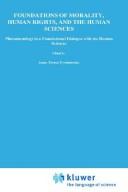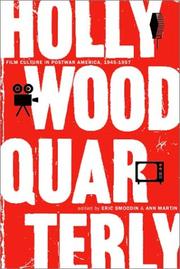| Listing 1 - 10 of 92 | << page >> |
Sort by
|
Article

Year: 2002
Abstract | Keywords | Export | Availability | Bookmark
 Loading...
Loading...Choose an application
- Reference Manager
- EndNote
- RefWorks (Direct export to RefWorks)
Horse. --- Retrospective. --- Surgery. --- Windsucking.
Book
Abstract | Keywords | Export | Availability | Bookmark
 Loading...
Loading...Choose an application
- Reference Manager
- EndNote
- RefWorks (Direct export to RefWorks)
Exhibitions --- Industriële vormgeving. --- Kunstnijverheid. --- Trade shows --- Exposition rétrospective d'art industriel
Article

Year: 2002
Abstract | Keywords | Export | Availability | Bookmark
 Loading...
Loading...Choose an application
- Reference Manager
- EndNote
- RefWorks (Direct export to RefWorks)
We identified risk factors associated with falling during steeplechase racing. We used retrospective data from all steeplechase runs on UK racecourses during 1999: 10,866 starts with 647 horse falls. The relationship between continuous variables and falling was assessed using generalised additive models (GAMs). Polynomial fits then were included in a multilevel, multivariable logistic-regression model. The number of runners had a linear, positive association with the risk of falling. The distance of the race had a non-linear relationship with the risk of falling; the risk steadily increased in races up to 23 furlongs (1 furlong~198 m), and then decreased in longer races. Age also had a significant, non-linear relationship with the risk of falling: a decreasing risk up to 12 years of age followed by an increasing risk in older horses. Horses that wore visors and had raced previously were associated with a decrease in the risk of falling. Intra-class correlation coefficients (ICCs) showed that although most of the variation resided at the start (level 1), a proportion of variation in the risk of falling could be attributed to horse and race. Trainer and jockey contributed very little to the variation in the risk of falling
Age. --- Association. --- Distance. --- Horse. --- Horses. --- Level. --- Model. --- Models. --- Retrospective. --- Risk-factors. --- Risk. --- Variation.
Book
ISBN: 3111325997 9783111325996 3598211317 Year: 2017 Publisher: Berlin ; Boston : De Gruyter Saur, K.G. Saur,
Abstract | Keywords | Export | Availability | Bookmark
 Loading...
Loading...Choose an application
- Reference Manager
- EndNote
- RefWorks (Direct export to RefWorks)
Retrospective conversion (Cataloging) --- Cataloging of rare books --- Rare books --- Conversion of bibliographic data to machine-readable form --- Recataloging of bibliographic data to machine-readable form --- Retrospective catalog record conversion --- Cataloging --- Machine-readable bibliographic data
Article

Year: 2002
Abstract | Keywords | Export | Availability | Bookmark
 Loading...
Loading...Choose an application
- Reference Manager
- EndNote
- RefWorks (Direct export to RefWorks)
We identified risk factors associated with falling during steeplechase racing. We used retrospective data from all steeplechase runs on UK racecourses during 1999: 10,866 starts with 647 horse falls. The relationship between continuous variables and falling was assessed using generalised additive models (GAMs). Polynomial fits then were included in a multilevel, multivariable logistic-regression model. The number of runners had a linear, positive association with the risk of falling. The distance of the race had a non-linear relationship with the risk of falling; the risk steadily increased in races up to 23 furlongs (1 furlong similar to 198 m), and then decreased in longer races. Age also had a significant, non-linear relationship with the risk of falling: a decreasing risk up to 12 years of age followed by an increasing risk in older horses. Horses that wore visors and had raced previously were associated with a decrease in the risk of falling. Intra-class correlation coefficients (ICCs) showed that although most of the variation resided at the start (level 1), a proportion of variation in the risk of falling could be attributed to horse and race. Trainer and jockey contributed very little to the variation in the risk of falling. (C) 2002 Elsevier Science B.V. All rights reserved
Age. --- Association. --- Boxes. --- Distance. --- Falling. --- Fatalities. --- Flat. --- Generalised additive models. --- Horse. --- Horses. --- Level. --- Model. --- Models. --- Multilevel models. --- Racehorse. --- Random effects. --- Retrospective. --- Risk-factors. --- Risk. --- Steeplechasing. --- Time. --- Uk. --- Variation.
Book
ISBN: 3789020311 Year: 1990 Publisher: Baden-Baden Nomos
Abstract | Keywords | Export | Availability | Bookmark
 Loading...
Loading...Choose an application
- Reference Manager
- EndNote
- RefWorks (Direct export to RefWorks)
Retroactive laws --- -Retroactive judicial decisions --- -#RBIB:XTOF --- AA / International- internationaal --- 334.154.0 --- T01 Droit européen général - Algemeen europees recht --- Intertemporal law --- Retroactivity (Law) --- Retrospective laws --- Constitutional law --- Due process of law --- Retroactive judicial decisions --- Vested rights --- Decisions, Retroactive judicial --- Retrospective judicial decisions --- Judgments --- Prospective overruling --- Gemeenschapsrecht. Integratie van de wetgeving: algemeenheden. --- #RBIB:XTOF --- Gemeenschapsrecht. Integratie van de wetgeving: algemeenheden
Article
Abstract | Keywords | Export | Availability | Bookmark
 Loading...
Loading...Choose an application
- Reference Manager
- EndNote
- RefWorks (Direct export to RefWorks)
Unilateral spatial neglect refers to a difficulty in detecting or acting on information in a particular region of space. When asked to cross out stimuli distributed across a page, patients with neglect may miss many targets on the left. In addition, they have a tendency to return to, and remark, right-sided targets that they have already cancelled. A recent retrospective study has shown this effect to be specific to unilateral neglect rather than a consequence of right hemisphere damage in general. Here, a consecutive group of seven right-hemisphere neglect patients performed five versions of a standard cancellation task, each version differing in the quantity of left-sided information presented. All of the participants showed perseveration on right-sided targets in the basic task. A highly significant and linear reduction in perseverative behaviour was observed as left-sided information was removed. In a second study, left-sided targets were again progressively removed but, in this case, were replaced with an additional distracter item, keeping the total quantity Of stimuli presented in each condition constant. Again, a significant reduction in right-sided perseveration was observed, indicating a high degree of selectivity to the effect. The results show that difficulty in perceiving existing, cancellation marks, or a non-spatially specific motoric perseveration, are unlikely to fully account for this behaviour. As the patients omitted almost all targets on the left side of the basic cancellation task, the results Suggest a striking, influence on apparently intentional behaviour front un-cancelled information within the neglected field. (C) 2002 Elsevier Science Ltd. All rights reserved
Acute stroke. --- Attention. --- Behaviour. --- Brain. --- Damage. --- Field. --- Frontal. --- Group. --- Hemisphere. --- Palietal. --- Parietal. --- Perseveration. --- Recovery. --- Reduction. --- Rehabilitation. --- Retrospective. --- Space. --- Spatial working-memory. --- Spatial. --- Stimuli. --- Striking. --- Stroke. --- Task. --- Visual neglect. --- Visuospatial neglect.
Article
Year: 2004
Abstract | Keywords | Export | Availability | Bookmark
 Loading...
Loading...Choose an application
- Reference Manager
- EndNote
- RefWorks (Direct export to RefWorks)
Reasons for performing study: Falls during racing present a risk of injury to both horse and jockey and a risk of fatality to horses. Objectives: To use video recordings of races to describe the circumstances surrounding horse falls at hurdle and steeplechase fences and to identify and quantify within-race risk factors for horse falls in National Hunt racing in the UK. Methods: A retrospective, matched, nested case-control study using video recordings of races was conducted on 6 UK racecourses. Cases and controls were matched on both race type and jump number at which the fall occurred. Conditional logistic regression analysis was used to examine the univariable and multivariable relationship between predictor variables and the risk of failing. Results: The risk of falling was significantly associated with whip use and race progress. Horses which were being whipped and progressing through the race were at greater than 7 times the risk of falling compared to horses which were not being whipped and which had no change in position or lost position through the field. Conclusions: This study has identified whip use and the position of the horse with respect to others in the field as potential risk factors for horse falls. Potential relevance: If these findings are confirmed by the use of intervention trials (eg. with whip-free or restricted whip use races), modifications could be introduced which would reduce the frequency of horse falls, leading to improved equine welfare
Analysis. --- Cohort. --- Control. --- Eg. --- Equine. --- Fatalities. --- Fatality. --- Field. --- Frequency. --- Horse. --- Horses. --- Hurdle. --- Injuries. --- Injury. --- Method. --- Musculoskeletal injuries. --- Physical inspection. --- Position. --- Racehorse. --- Relevance. --- Retrospective. --- Risk-factors. --- Risk. --- Thoroughbreds. --- Time. --- Uk. --- Video. --- Welfare.

ISBN: 9027714533 9400969775 9400969759 9789027714534 Year: 1983 Volume: 15 Publisher: Dordrecht: Reidel,
Abstract | Keywords | Export | Availability | Bookmark
 Loading...
Loading...Choose an application
- Reference Manager
- EndNote
- RefWorks (Direct export to RefWorks)
Social sciences and ethics. --- Science --- Phenomenology. --- Moral and ethical aspects. --- Morals. --- Science. --- Phenomenology --- -Social sciences and ethics --- #GROL:SEMI-1-05'19' Huss --- Ethics and social sciences --- Social ethics --- Natural science --- Science of science --- Sciences --- Philosophy, Modern --- Morality --- Retrospective Moral Judgment --- Moral and ethical aspects --- Social sciences and ethics --- Morals --- Science and ethics --- Science - Moral and ethical aspects.

ISBN: 0520232739 0520232747 0520936329 9786612762604 159734656X 1282762605 9780520936324 1417525444 9781417525447 9781597346566 9780520232730 9780520232747 9781282762602 6612762608 Year: 2002 Publisher: Berkeley : University of California,
Abstract | Keywords | Export | Availability | Bookmark
 Loading...
Loading...Choose an application
- Reference Manager
- EndNote
- RefWorks (Direct export to RefWorks)
The first issue of Hollywood Quarterly, in October 1945, marked the appearance of the most significant, successful, and regularly published journal of its kind in the United States. For its entire life, the Quarterly held to the leftist utopianism of its founders, several of whom would later be blacklisted. The journal attracted a collection of writers unmatched in North American film studies for the heterogeneity of their intellectual and practical concerns: from film, radio, and television industry workers to academics; from Sam Goldwyn, Edith Head, and Chuck Jones to Theodor Adorno and Siegfried Kracauer. For this volume, Eric Smoodin and Ann Martin have selected essays that reflect the astonishing eclecticism of the journal, with sections on animation, the avant-garde, and documentary to go along with a representative sampling of articles about feature-length narrative films. They have also included articles on radio and television, reflecting the contents of just about every issue of the journal and exemplifying the extraordinary moment in film and media studies that Hollywood Quarterly captured and helped to create. In 1951, Hollywood Quarterly was renamed the Quarterly of Film, Radio, and Television, and in 1958 it was replaced by Film Quarterly, which is still published by the University of California Press. During those first twelve years, the Quarterly maintained an intelligent, sophisticated, and critical interest in all the major entertainment media, not just film, and in issue after issue insisted on the importance of both aesthetic and sociological methodologies for studying popular culture, and on the political significance of the mass media.
Motion pictures --- Cinéma --- History --- Social aspects --- Histoire --- Aspect social --- Culture in motion pictures. --- History. --- 20th century. --- academics. --- anthology. --- avant garde film. --- discussion books. --- documentary. --- entertainment. --- essay collection. --- film culture. --- film historians. --- film journalism. --- film scholars. --- film students. --- film studies. --- historical. --- hollywood. --- intellectual perspective. --- journal archives. --- leftist utopianism. --- mass media. --- media studies. --- narrative films. --- nonfiction. --- pop culture. --- postwar america. --- retrospective. --- sociological. --- textbooks. --- united states.
| Listing 1 - 10 of 92 | << page >> |
Sort by
|

 Search
Search Feedback
Feedback About UniCat
About UniCat  Help
Help News
News